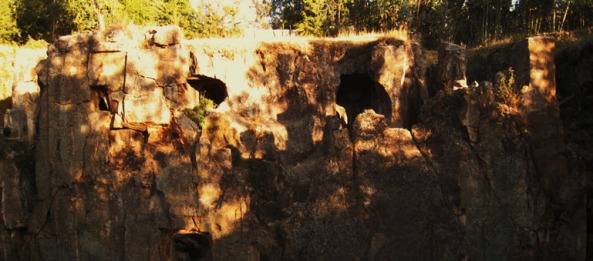Shortly before Christmas, I visited the Washa Mikael Church. The exact age of this rock-hewn church on the outskirts of Addis is somewhat unknown: guide books say that it most likely dates back to the 12th Century, but some priests and locals maintain that it dates back to 3rd Century AD, making it more than 1600 years old. The church is somewhat elusive, no one knew where it was or had even heard of it, thus it took us several hours of driving around in the wrong directions to find. In the end we asked taxi drivers, because we thought they would know the tourist attractions. After we came home I searched on the internet and discovered that most people get to it by hiking for hours on a guided tour in the mountains. Our driver did well to find it! The church is made entirely from stone – like Lalibella it was carved from one piece of rock – in this case basalt.
When we arrived we were greeted by a local who farms the land. I don’t know how many tourists make it to the church – I wouldn’t be surprised if most give up before getting there! – because he seemed really happy to see us. He was a delightful man who gave us a thorough tour of the church (a bit too thorough for me – the rocks looked pretty crumbly and fractured and I didn’t really want to go gaily wandering through the old ruins!) He told us that the church was over 1600years old and that it had been built by two Ethiopian kings in around 320AD, making it older than Lalibella. The two Kings were originally called Ezana and Sayzana but in ~320AD they were re-named Abraha and Alshaba. Ethiopian Kings apparently get three names: the baptism name, their original name and their “king” name.
From birds’ eye view, the church is the shape of the letter “U” – which is read as “Ha” in the Amharic alphabet. Apparently this “U” represents the phrase “Halwotule ab emkdme alem”….which means “Before anything existed, God was here”
The church apparently stopped giving service in 1878 when a wall collapsed. Rumour has it that the church was also bombed during the Ethio-Italian war between 1928 and 1933. Locals claim that it was bombed by facists.
The church originally had 7 windows (some still partially remain) to represent 7 days, 7 skies and 7 angels. Before it was bombed it apparently also stood 7m high. But now the roof is missing. Entrance into the church is through a tunnel which passes underground. Once inside you can visit the priests room, the baptism room and the main altar – or what remains of each of these. The baptism room has a window – the mother would stand outside and pass the baby through, as only the priest was allowed inside.
The church was mainly cool for what it was, not what it left of it. The walls are kind of dicey and I didn’t want to stand under them for long! I could just hear Tim in my head ranting to me about safety! The guide told me that no one knows how much further down the church goes. He mused that it may go much deeper but no one knows, because it may have been filled in with soil. However, he also told me that the church is 7m in height so if that is the case, I don’t think it would go much below what it does now…..
The entrance to the church is through this tunnel. The church was built down into the ground
Entrance to the church itself – rocks at the top balanced precariously…..!
View over the church from the side
The baptism window. The mother would wait here with the baby before passing it through the window to the priest for baptism







